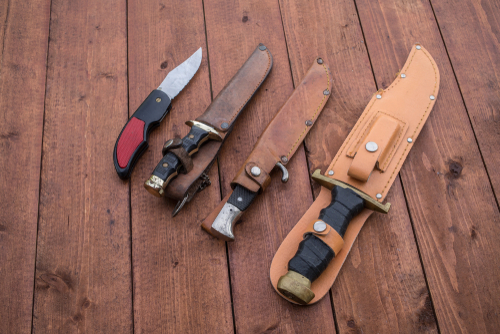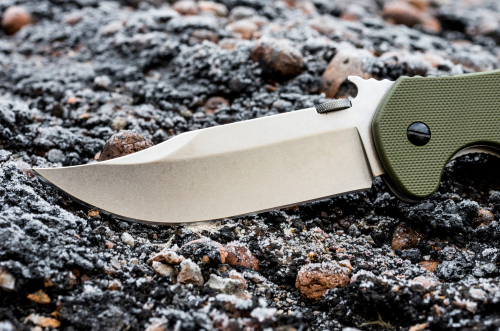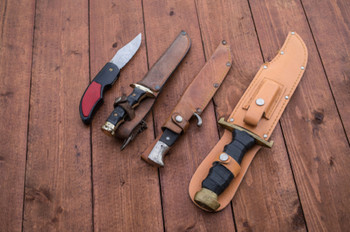Interesting Facts About Custom Survival Knives You May Have Not Known
Nov 11th 2021

Throughout history, the ownership of a finely crafted knife is not just a matter of survival, but honor and tradition. Whether they are military issued knives or custom survival knives, these blades have played their role in shaping history.
Emerson CQC 7
The CQC-7 has been a staple of Emerson Knives. The CQC stands for Close Quarter Combat, and the CQC-7 was designed for that intent.
The Emerson CQC-7 is a highly sought-after folding tactical knife. The razor-sharp, chisel-ground blade is arguably the gold standard by which modern tactical knives are judged on.
This was the knife used as a weapon during the capture of Osama bin Laden.
Emerson knives have been a mainstay in the SEAL Team 6 mission loadout for years. The CQC-7 played its role in the legendary raid to capture Osama bin Laden in 2011.
In 2013, a member of the raid under the pseudonym of Mark Owen auctioned off his CQC-7 to raise $35,400 for a fellow Navy SEAL who died during a training accident.

Chris Kyle Knives
Chris Kyle, the renowned sniper which the film American Sniper was based on, was murdered on February 2nd, 2013. However, just ten days before his death, he sat down with Ernest Emerson to design a knife.
To honor his death, Emerson built a custom survival knife in his memory, based on the CQC-6. The blade is engraved on both sides. Some of the engravings include a SEAL Trident and the words “We Sleep Soundly in Our Beds … Because Rough Men Stand Ready to Do Violence.”
But Emerson wasn’t the only company that built knives in Kyle’s name. Protech Knives built a set of TR-4 knives in collaboration with the Chris Kyle Frog Foundation, a group that helps military veterans and their families. This specially built TR-4 features a handle that is marked with Chris Kyle Frog Foundation’s logo—a mashup of Kyle’s tattoos that signify his commitment to his nation and a frog skeleton that symbolizes fallen U.S. Navy Seals.
Fathers of the Hunting Knife
Before the end of the 19th century, military personnel and hunters used knives that were no different from those used by butchers. The blades were weak, and the handles were flimsy.
Webster L. Marble saw the need for a survival knife capable of performing tasks in the great outdoors and introduced the concept of the “hunting knife.”
During the Vietnam War, Randall, an American custom knife manufacturer, saw the need for purpose-built survival knives. Randall took the feedback from combat personnel in the field and made changes to the existing Number 14 “Attack” Model, such as implementing a serrated edge for sawing through downed aircraft fuselage (for rescue operations) and a hollowed-out handle for stowing survival gear.
The result became the first of the modern survival knife that we still see today.
Knives with Long Histories
Knives have been a subject of fascination long before modern military roots. These sharp blades inspired awe and curiosity and helped shaped the course of history.
Here are some of the oldest knives in history that are still used today.
Balisong
Commonly known as the butterfly knife, this popular knife style consists of a blade that has two handles that wrap around the blade when it's closed. However, when it comes to history, the origin of the balisong has often been a subject of dispute.
There are two schools of thought. Some believe that balisongs came from the Philippines, while others believe they came from France. Even though the balisong tradition is rich in the Philippines, there is a disturbing lack of physical evidence, which suggests that balisongs may not have a Filipino origin.
Some claims that balisongs came from France because it closely resembles a measuring tool from the 1700s called the Pied Du Roi (“foot of the king”).
Regardless of its true origins, performing tricks with the balisong (called “flipping”) remains a highly popular and mesmerizing hobby for any knife collector.
Karambit
Southeast Asia is the birthplace of several unique knife designs. One of the most popular knife styles still used today is the karambit. According to Javanese folklore, the design of the karambit was inspired by the claws of a tiger.
It was initially used as a farming tool designed to pull roots out of the ground but was then weaponized due to its deadly curve that maximizes cutting potential. This unique design eventually spread across the rest of Asia, with accounts of the karambit reaching as far as Europe. Because of the curved design, the wielder can easily strike at weak points such as the knees and elbows. This makes the karambit arguably the deadliest melee weapon ever designed.
Kukri
For several centuries, the kukri was a short and curved blade that was steeped in Nepalese military tradition. When the British forces from the East India Company first fought the Nepalese Gurkha soldiers, they were impressed by the locals’ deadly proficiency with the kukri. The Nepalese were able to chop off arms and legs or eviscerate a horse with a single kukri strike. This convinced the British to recruit them as an elite military force in their army.
Even today, the Gurkhas continue to dominate as one of the world’s toughest military units. Kukris are still prized for their distinctive blade design and superior slashing power.

